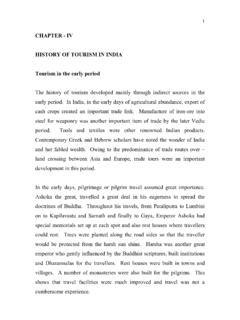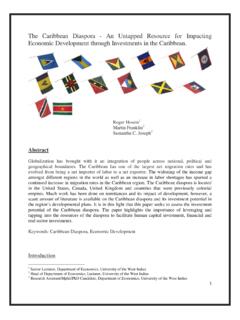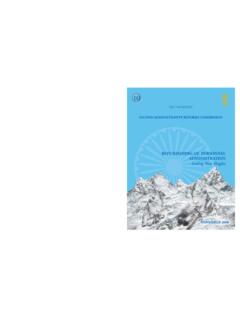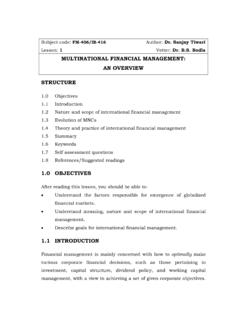Transcription of Afghanistan: Post-Taliban Governance, Security, and U.S ...
1 Afghanistan: Post-Taliban Governance, Security, and Policy Kenneth Katzman Specialist in Middle Eastern Affairs Clayton Thomas Analyst in Middle Eastern Affairs December 13, 2017 Congressional Research Service 7-5700 RL30588 Afghanistan: Post-Taliban Governance, Security, and Policy Congressional Research Service Summary The United States, partner countries, and the Afghan government are attempting to reverse recent gains made by the resilient Taliban-led insurgency since the December 2014 transition to a smaller international mission consisting primarily of training and advising the Afghanistan National Defense and Security Forces (ANDSF). The Afghan government has come under increasing domestic criticism not only for failing to prevent insurgent gains but also for its internal divisions that have spurred the establishment of new political opposition coalitions.
2 In September 2014, the United States brokered a compromise to address a dispute over the 2014 presidential election, but a September 2016 deadline was not met for enacting election reforms and deciding whether to elevate the Chief Executive Officer (CEO) position to a prime ministership. The Afghan government has made some measurable progress in reducing corruption and implementing its budgetary and other commitments. It has adopted measures that would enable it to proceed with new parliamentary elections, but no election date has been set. The number of forces in Afghanistan, which peaked at about 100,000 in 2011, is reportedly about 15,000, of which most are assigned to the NATO-led Resolute Support Mission (RSM) that trains, assists, and advises the ANDSF.
3 About 2,000 of the contingent are involved in combat against Al Qaeda and other terrorist groups, including the Afghanistan branch of the Islamic State organization (ISIL-Khorasan), under Operation Freedom s Sentinel (OFS). In August 2017, after several months of deliberation, President Trump announced a new strategy that includes several thousand additional forces to help Afghan forces break a stalemate in combat against insurgent groups, as well as expanded authorities to strike Taliban targets. The strategy also appears to signal a intent to more assertively pressure Pakistan to deny safe haven to Afghan militants. officials assert that insurgents control or contest about 40% of Afghan territory, but still are not positioned to overturn the government.
4 In May 2016, the vulnerabilities of the Taliban were exposed when the United States tracked and killed with an unmanned aerial vehicle strike the head of the Taliban, Mullah Akhtar Mohammad Mansour. However, the successor Taliban leadership has continued to produce battlefield gains and rejects new settlement talks with the government. One small insurgent group reached a settlement with the government in late September 2016, but the agreement has not, to date, broadened to other groups. Afghanistan s minorities and women s groups assert concerns that a settlement with the Taliban might erode post-2001 human rights gains. forces have helped Afghan units kill several successive leaders of the Islamic State affiliate in Afghanistan, but without defeating the group outright.
5 A component of policy to help establish a self-sustaining Afghanistan is to encourage economic development and integration into regional trading patterns. However, Afghanistan will remain dependent on foreign aid for many years. Through the end of FY2016, the United States provided about $111 billion to Afghanistan since the fall of the Taliban, of which about 60% has been to equip and train the ANDSF. These figures do not include funds for military operations in Afghanistan. The FY2017 appropriation for the ANDSF is $ billion; allocations to Afghanistan from economic assistance account appropriations have not yet been finalized. For FY2018, the Trump Administration has requested $ billion for the ANDSF, as well as funding for a number of other priorities, including $650 million in economic support.
6 Afghanistan: Post-Taliban Governance, Security, and Policy Congressional Research Service Contents Background .. 1 18th Century to the early 20th Century .. 1 Independence and the Cold War Era .. 1 Soviet Invasion and Occupation Period .. 2 The Seven Major Mujahedin Parties and Their Activities .. 2 Geneva Accords (1988) and Soviet Withdrawal .. 3 The Mujahedin Government and Rise of the Taliban .. 3 Taliban Rule (September 1996-November 2001) .. 4 Policy toward the Taliban Regime and its Hosting of Bin Laden .. 5 The Northern Alliance Congeals .. 5 Bush Administration Afghanistan Policy Before the September 11 Attacks .. 6 September 11 Attacks and Operation Enduring Freedom.
7 6 Major Combat Operations: 2001-2003 .. 7 Afghan Governance .. 7 National Unity Government of Ashraf Ghani and Dr. Abdullah .. 8 Growing Fragmentation .. 10 Way Forward for the NUG .. 11 and International Civilian Policy Structure .. 12 General Human Rights Issues .. 14 Advancement of Women .. 14 Religious Freedoms .. 16 Human Trafficking .. 16 Security Policy: Transition and Beyond .. 17 Who Is The Enemy ? .. 17 The Taliban .. 18 Al Qaeda and Associated Groups .. 18 The Islamic State-Khorasan Province (ISKP) .. 20 Haqqani Network .. 21 Insurgent Tactics .. 22 Insurgent Financing: Narcotics Trafficking and Other Methods .. 23 The Anti-Taliban Military Effort: 2003-2009.
8 23 Obama Administration Policy: Surge, Transition, and Drawdown .. 24 Transition and Drawdown: Afghans in the Lead, 2011-2014 .. 25 Resolute Support Mission (RSM) and Further Drawdowns .. 26 Adjustments to Force Levels in Light of Security Deterioration .. 26 Bilateral Security Agreement (BSA) .. 30 Strategic Partnership Agreement (SPA) .. 30 Building Afghan Forces and Establishing Rule of Law .. 31 Size and Other Features of the ANDSF .. 32 ANDSF Funding .. 33 The Afghan National Army (ANA) .. 33 Afghan Air Force (AAF) .. 34 Afghan National Police (ANP) .. 35 Rule of Law/Criminal Justice Sector .. 36 Reintegration and Potential Reconciliation with Insurgents .. 37 Hikmatyar Faction (HIG) and its Reconciliation with the Government.
9 38 Afghanistan: Post-Taliban Governance, Security, and Policy Congressional Research Service Reintegration .. 39 Regional Dimension .. 41 Pakistan .. 43 Cooperation on 45 Iran .. 46 Iran s Development Aid for Afghanistan .. 47 India .. 47 Russia, Central Asian States, and China .. 49 Russia .. 49 Central Asian States .. 50 China .. 52 Persian Gulf States .. 53 Aid and Economic Development .. 54 Assistance to Afghanistan .. 55 Aid Oversight and Conditionality .. 55 Aid Authorization: Afghanistan Freedom Support Act .. 55 Direct Support to the Afghan Government .. 56 Other Donor Aid/Oversight/Tokyo Mutual Accountability Framework .. 57 Development in Key Sectors.
10 58 Education .. 59 Health .. 59 Roads .. 59 Bridges .. 60 Railways .. 60 Electricity .. 60 Agriculture .. 61 Telecommunications .. 62 Airlines .. 62 Mining and Gems .. 62 Oil, Gas, and Related Pipelines .. 64 Trade Promotion/Reconstruction Opportunity Zones .. 65 Figures Figure 1. Map of Afghanistan .. 73 Figure 2. Map of Afghan Ethnicities .. 74 Tables Table 1. Post-Taliban Political Process Milestones .. 8 Table 2. Assistance Mission in Afghanistan (UNAMA) .. 13 Table 3. Background on NATO Participation and Mandate .. 24 Table 4. Summary of Strategy and Implementation .. 32 Table 5. Major Security-Related Indicators .. 40 Table 6. Afghan and Regional Facilities Used for Operations in and Supply Lines to Afghanistan.















